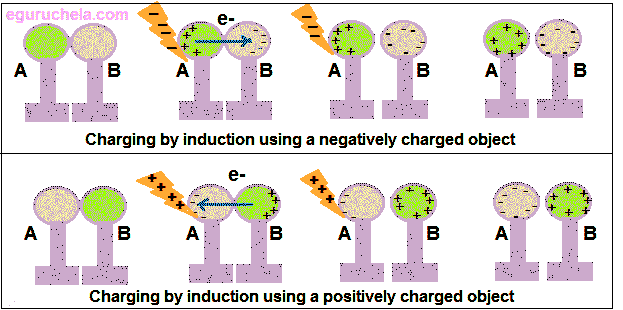Charging by Induction
Electrostatic induction also known as "Electrostatic Influence" or simply "Influence" in Europe and Latin is a redistribution of electrical charge in an object, caused by the influence of nearby charges.
In the presence of a charged body, an insulated conductor develops a positive charge on one end and a negative charge on the other end.
Induction was discovered by British scientist John Canton in 1753 and Swedish professor Johan Carl Wilcke in 1762. Electrostatic generators, such as the Wimshurst machine, the Van de Graaff generator and the electrophorus, use this principle.
Due to induction, the electrostatic potential is constant at any point throughout a conductor.
Electrostatic Induction is also responsible for the attraction of light nonconductive objects, such as balloons, paper or styrofoam scraps, to static electric charges
Example :
An example of an induction charging of two metal spheres. The metal spheres are supported by insulating stands so that any charge acquired by the spheres cannot travel to the ground.
The spheres are placed side by side (see diagram below) so as to form a two-sphere system. Being made of metal (a conductor), electrons are free to move between the spheres - from sphere A to sphere B and vice versa .
Types of Charging with Examples
Charging means gaining or losing electron. Matters can be charged with three ways, charging by friction, charging by contact and charging by induction.
Charging by Friction
When you rub one material to another, they are charged by friction. Material losing electron is positively charged and material gaining electron is negatively charged.
Amount of gained and lost electron is equal to each other. In other words, we can say that charges of the system are conserved.
When you rub glass rod to a silk, glass lose electron and positively charged and silk gain electron and negatively charged.
Charging by Contact
There are equal numbers of electrons and protons in a neutral matter. If something changes this balance we can say it is charged.
Charging By Induction
Using a negatively charged system :
When a negatively charged object is brought near a spherical system, the electrons in the sphere will be forced to move away due to repulsion. Due to the migration of electrons, sphere A becomes completely positive and sphere B becomes negative.
Using a positively charged system :
When a positively charged object is brought near the system of the sphere, the electrons from the sphere B will move to the sphere A due to the force of attraction.
Now, sphere A gets negatively charged and sphere B gets positively charged.

Using a electroscope :
The electroscope is commonly used by physics teachers to demonstrate the electrostatic principles of charging and charge interactions.
It is used to detect the presence and magnitude of electric charges on a body.
